Crampons vs Microspikes: Getting Through the Snow
As you are gearing up for your snow adventures you may find yourself looking through your favorite outdoor adventure store for a little extra help walking through the snow. Depending on the type of adventure that you are after, you have a few different options that you can add on to your boots to help you climb up the snow topped mountain.
[the_ad_group id=”21″]
If you are looking for something a little more adventurous than your average snowshoeing trip, than you are probably debating between crampons vs microspikes. In this article, we will help you learn the differences between the two, how to utilize them best, and a few tips for enjoying your favorite outdoor activities in the snow.
The Goal of Microspikes and Crampons
When you are doing your favorite hiking loop, or taking on a new challenge in the snow or the ice you are going to need some extra traction to avoid falling down. Having gear that attaches to your regular hiking shoes will help give you more traction that can easily grapple the ice you will encounter. Even hiking shoes with excellent treading cannot provide the support you will need when going up hill or even walking on an even surface.
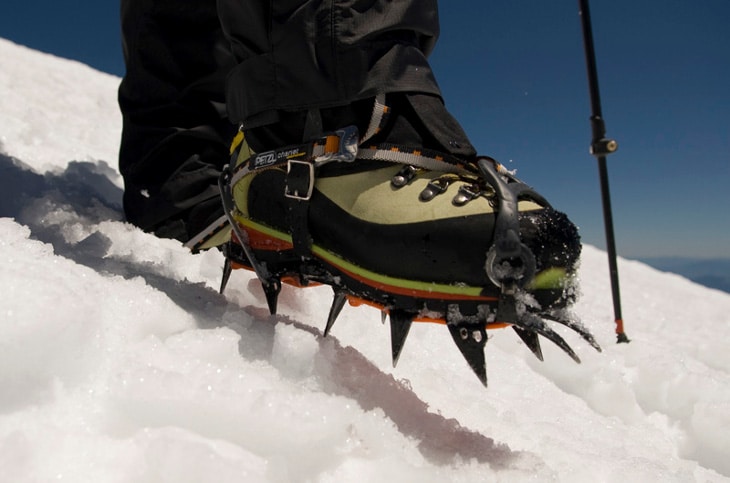
While wearing these traction devices in ice can keep you safe and help you hike without slipping, you should try not to put on your device until absolutely necessary. While microspikes or crampons may seem light, we suggest that you don’t attempt to use them when unnecessary. Having any type of spikes on your shoes will not only increase the weight but also will make your hike more arduous.
*Useful Winter Tip: Feeling a little uneasy gliding through the ice? Or are you planning on taking a heavy backpack or backpacking bag? Consider renting or purchasing hiking poles to give you extra stability and balance. When you are sliding around, especially on steep trails, having poles to provide balance will not only make you more comfortable but also a lot safer.
Microspikes
So, what exactly are microspikes? The spikes are held together to grip ice with a rubber frame and chains surrounding the shoes. The spikes tend to be shorter for more mobility and provide you with just the right amount of traction for hiking trails that have been overrun with ice and snow.
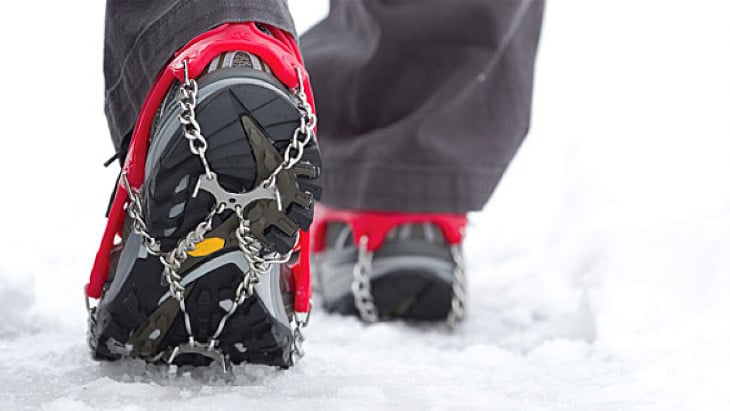
Also, unlike crampons, they are light weight and flexible, meaning that you can even use a set of microspikes to go on a run in your icy neighborhood. The point to these shoes is for hikers and snow sportsman who are not going up to serious trails, yet still need support walking around icy terrain. They can be attached to running shoes and used in a multitude of settings.
When should I use a microspike?
This device is best used for level trails instead of attempting to tackle steep mountain ranges. The smaller spike makes the device more versatile along pathways but they will not provide you the strength or the length you may need when hiking up to higher elevations.
In addition, level trails tend to have fewer rocks and diversity on the trail itself, and are more user-friendly, meaning that you won’t be as worried about stepping on ice covered and slippery rocks. If the trail you are hiking is known for difficult paths, then microspikes may not provide you the support needed.
Microspikes can also be used in your everyday life if you live in a snowy area. Some people opt to use them when shoveling sidewalks or taking a trip in heavy ice area. Because they are so easy to remove from your shoes, you can slip them off after shoveling or your errands and walk on non-icy surfaces.
How do I use microspikes?
Luckily for all of us, microspikes are easy to use, easy to pack, and relatively easy to find in an outdoor-focused store. Microspikes can be worn with either a sturdy hiking boot or a regular shoe, however, we suggest a hiking boot with rubber on the outside. When trudging through the snow, this device will not prevent your feet from getting soaked through.
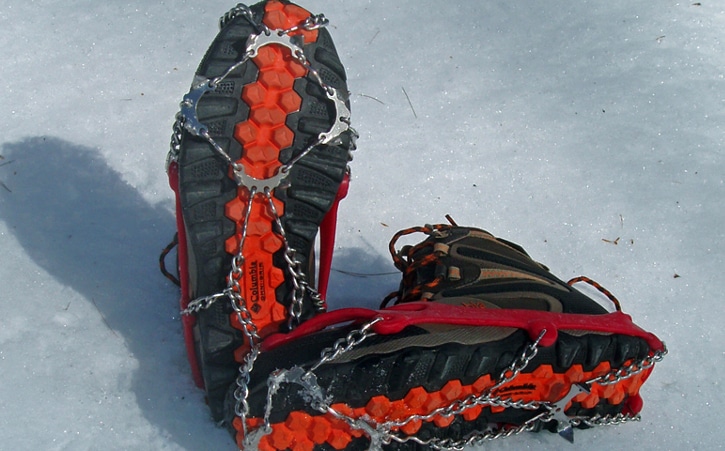
Depending on what company made your microspikes, simple place them spike down, step into them and secure tightly to your shoe with rubber frame straps attached. As you are walking through the snow the device will give you sure and steady steps and help prevent injury.
*Quick Tip: In the microspikes vs crampon debate, remember that to really make the decision about which to wear, you need to check the conditions of the hiking trail. Even if you are on a fairly even surface microspikes may still not be your best option. For days with heavy snowfall and limited compacted ice, both crampons and microspikes are not going to offer you support. Instead, try snowshoeing to stay afloat on top of the ice.
Crampons
Now that we understand microspikes and their various usages, you may be wondering how a crampon is defined and used. Crampons are traditionally used mountaineering and various types of ice climbing.
This heavy duty winter device is attached to mountaineering boots and has a mostly rigid frame that supports a horizontal bar, bindings, straps and sharp blades. There are quite a few different options for you to choose from when looking for a crampon that we will break down for you.
Points in a Crampon
As an ice adventurer, you typically have two options about the amount of points, or blades on your crampon. There is the traditional 10-point crampon and the 12-point crampon, each offering different benefits depending on the type of sport.
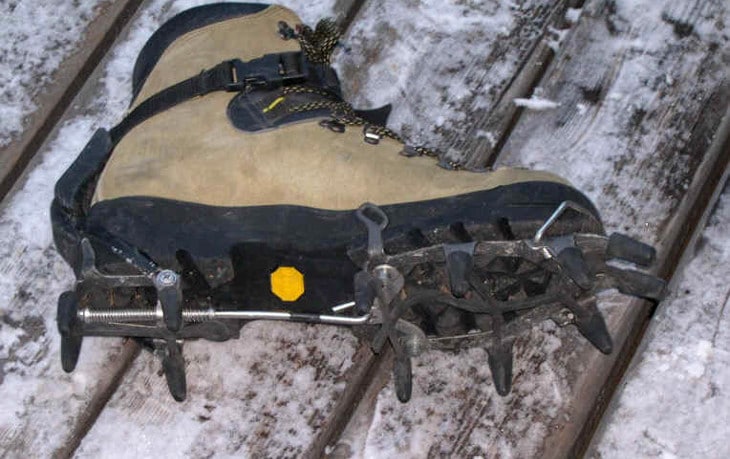
With both of the options, you will need to make sure that the points are placed correctly under your foot to ensure proper use. For most skiers or glacier trekkers using crampons to navigate mountains, a 10-point crampon will do the trick, but as you move from mountaineering to climbing on the ice, you are going to need more points.
Bindings and Your Boots
Most stores are going to offer you different types of crampons that have binding options, and depending on your activity and the boots you plan on wearing you may need different bindings. There are three major types of bindings, and a good shopper will bring the boots they tend on wearing with them to determine the right crampon. Be open to the idea that you may need new winter boots for properly fitting crampons.
Step in
If you are a cross country skier looking for crampons to aid your journey, then the step in crampon is the one for you. Fitted with a wire bail and a tension lever the crampon is a rigid system that holds you boot in place. When fitted correctly it is the most secure system you can purchase.
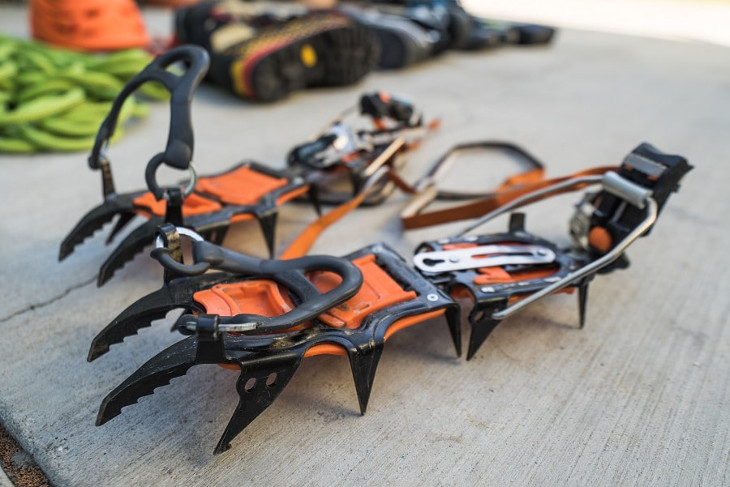
Most steps in crampons come with an ankle strap for extra security. The downside to this system is that you need specific boots that are rigid and have grooves on both the heel and toe. This being said, this gear is the easiest to put on, built to last, and adjustable for different terrain.
Hybrid
Simple to use and effective with the right boot, these hybrid crampons are the best option for individuals with rigid boots and only a heel groove. What makes this type a hybrid is its stiff heel lever mixed with a simple toe strap. It is both sturdy and flexible.
[the_ad_group id=”22″]
The pros are that you don’t necessarily need a new boot with this type of crampon, and it it is easy to put on in winter weather. However, you will have less of the rigid security as the step in, and its points are not as adjustable.
Strap on
The strap on crampon is perhaps the most flexible option for those who may not have crampon specific boots. Because of the nylon material used in the straps it fits over a large variety of boots.
There are two major cons to a strap on system: they tend to take longer to put on and they are not as precise as a classic step in. The plus side to this model is that you can adjust it to fit snuggly, and you can use it with different footwear for different trips.
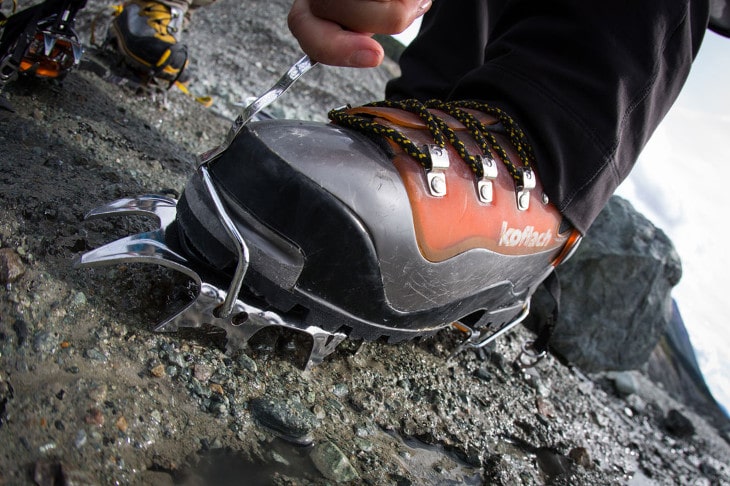
When selecting your crampon, consider the types of activities that you are going to be engaging in, will you be doing challenging technical climbs or are you doing more multipurpose climbing up mountains? Testing out and trying your first crampon is normally quite the experience, any outdoor gear salesman is going to have you bring in your own boots to figure out the bindings appropriate.
See also: Best Hiking Gaiters: Top 6 picks for 2018
Don’t be surprised when they want you to stand up will putting on your crampons for the first time. The best way to test them out, is to place the crampon on a rock or hard material simulating ice, lay them out, place your foot inside and put all your body weight onto the foot before strapping in. Try this out a few times before heading up to the alpines so you know exactly how to put on crampons and how to adjust them.
Technique
Crampons are more difficult to use than microspikes, which should be expected as you will be doing more alpine like climbs and hikes in a crampon. There are two major types of techniques that you should master before you do a challenging ascent:
French Technique (Flat footing)
Begin this technique by taking an open stance, will awkward at first you will flex your ankles until your feet are pointed directly downwards, as flat as possible. With your legs extended wide, take steady steps that push each of the blades down directly into the ice. In this technique style, you do not use the edge of your shoe or your crampon, which may feel awkward at first.
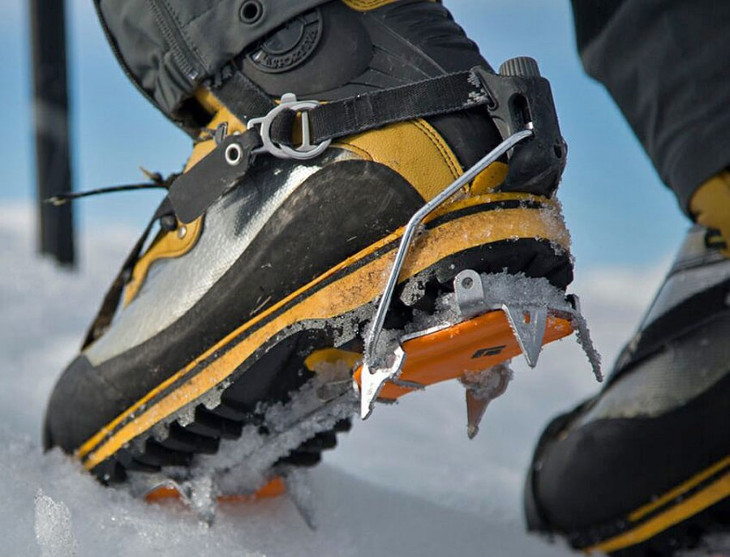
As the mountain begins to steepen you will notice that it becomes more difficult to flex your ankle, simply walk diagonally up the hill with a hiking pole or better, an ice axe, to keep balance. This technique is difficult to master and you should practice first on a slope that will provide safe passage, especially if you trip and fall.
*Useful tip: Crampons require quite a bit of practice as you are not walking naturally in them, and the already steep and difficult terrain gets even more challenging in the snow. This technique requires practice, but also confidence in your gear and your steps. Each foot placement must have all ten spikes in the snow securely so really trust each step as you ascend the mountain.
Front Pointing
Your feet, once again hip-width apart, take steps that dig the front points into the ice and step up. This technique is a bit more natural feeling and will help you up very steep slopes. If you are in ice, rather than hard snow, you need to really push the spikes into the ice than normal, however, once they are in do not wiggle around or it will loosen ice in front of you.
The downside to this more natural seeming technique is that you need to have a very rigid boot and very sharp points on your crampons. It also requires a lot of practice to keep your foot horizontal as you make your way up, otherwise, your top points will pop out of the snow. As you become fatigued during your ice exploring you will want to raise your heel to help create force, but this will only cause you to slip and slide.
Microspikes vs Crampons: The Quick Breakdown
Simply put, microspikes are the more flexible and lighter weight cousin of the crampon, and while they can’t be used in uphill terrain with dense ice, they will provide you safety on easier trails. Microspikes are not a replacement for crampons on your shoes, especially in mountain territory.
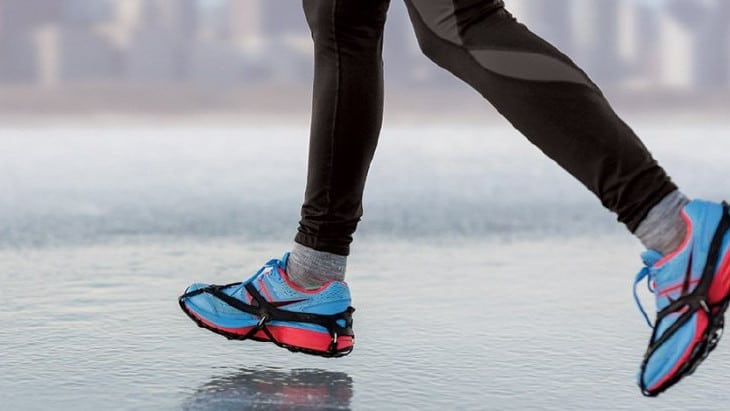
Crampons can be literally life-saving when you decide to trek up mountains in the winter and will provide you with the safety and comfort needed for unsure icy footing. Crampons are heavy, generally inflexible, and are meant to be used with a sturdy boot. Just be aware of doing your research and consulting an experienced winter hiker before heading out with your crampon. A fall in crampons can provide serious injury do the sharp blade. You might want to check our useful tips for hiking in winter for more information.
Unlike the microspikes, crampons take practice before you jump into your first big climb, you need to know how to put them on, how to adjust them, and how to walk in them. Climbing or mountaineering before you fully understand how crampons work can be deadly, and they require skill especially when you fall down.
[the_ad_group id=”23″]
An uncontrolled fall can lead to deep cuts and serious injury. While the crampon is excellent for mountaineering and snow climbing, its uses do not extend into the more casual trekking. In addition, the steepness and hard ice will require the purchase and use of an ice axe to assist in both your ascent and descent along the mountain trail.
Practice using an ice axe before going out as well as walking in crampons, as the proper technique will keep you from getting hurt up on the mountain.
For the serious mountaineer who wishes to traverse the highest peaks in the winter, a well-fitted crampon is going to make the trip safe and doable. Crampons are meant for more heavy duty ice climbing and alpine trekking. As you get to dense ice or hard snow you are going to be thankful that your firmly placed crampons are holding you steady on slopes.

Seeing beautiful winter views from the top of a snowy mountain makes the hassle of practicing in crampons worth it. That being said, for easier terrain or everyday activity microspikes attached to your boots or running shoes will do you just fine.
These lightweight and easy to pack designs come in a variety of styles with the goal of keeping you safe and comfortable. They are meant to simulate natural walking and hiking even with a layer of hard snow and ice.
Do check on our review of the top winter hiking gear for your needs. It’s a must-read for everyone!
Climb on
In order to really choose the type of traction device you need, assess the elevation and technicality of your trip and then check the ice conditions of the trail before choosing what gear to bring along. Any type of winter activity will require some extra preparation, especially if you are not used to the cold snowy conditions.
A good winter hike will require extra gear, extra calories, and extra planning to be both safe and fun! With both of these devices being aided by hiking poles, or for more serious slopes, an ice axe, will help you with balance and stability as you make your way across the rocky terrain. Also check out our review of the top hiking boots for wide feet for more information.

Have we missed something in our crampons vs microspikes article, or do you have a favorite brand for your winter treks? Let us know in the comments below!

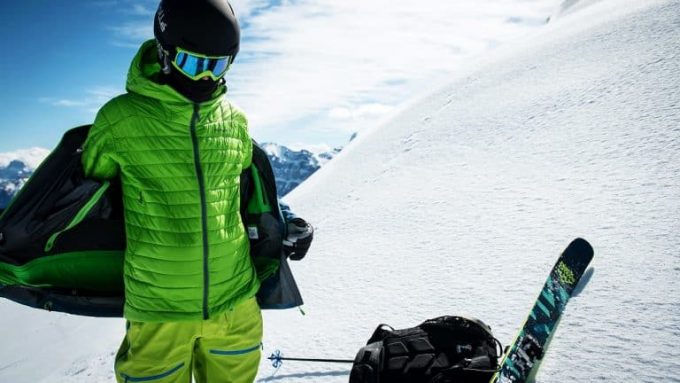


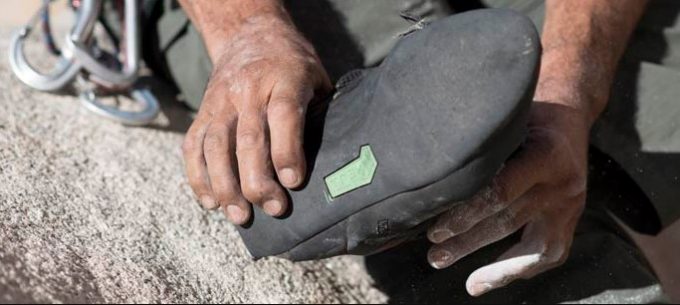


During winter I spend a lot of time in the mountains that have trails of really, really packed snow. It stays like that for a very long time in the last few years. Eventually, it turns into a very smooth ice, but at the beginning it’s just packed snow. It’s not very thick, maybe 2 inches. There are some slight slopes and some rocks in the ice.
I’m having problems balancing and I almost fell several times. Does anyone have a solution what to choose, microspikes or crampons?
If you are traveling with a group, it would be easier to recommend and bring both contraptions to be able to traverse what the terrain needs. However, I would recommend getting poles for added mobility and traction aside from whichever contraption you prefer to use.
I absolutely agree with you Dennis. I carry both microspikes and crampons in my backpack. You can never guess what the weather’s going to be like. It’s best to be 100% prepared. Then you just need to get them out of your backpack, try them and see how they behave on a certain surface.
If you don’t have enough space in your backpack, the only option is to guess what you’ll need, and that’s never easy.
It is better to be prepared on both scenarios. There are some treks that can be properly traversed with a crampon, others are easier when wearing microspikes. They are not very bulky, so I really recommend carrying both.
During winter I spend a lot of time in the mountains that have trails of really, really packed snow. It stays like that for a very long time in the last few years. Eventually, it turns into a very smooth ice, but at the beginning it’s just packed snow. It’s not very thick, maybe 2 inches. There are some slight slopes and some rocks in the ice.
I’m having problems balancing and I almost fell several times. Does anyone have a solution what to choose, microspikes or crampons?
If you are traveling with a group, it would be easier to recommend and bring both contraptions to be able to traverse what the terrain needs. However, I would recommend getting poles for added mobility and traction aside from whichever contraption you prefer to use.
I absolutely agree with you Dennis. I carry both microspikes and crampons in my backpack. You can never guess what the weather’s going to be like. It’s best to be 100% prepared. Then you just need to get them out of your backpack, try them and see how they behave on a certain surface.
If you don’t have enough space in your backpack, the only option is to guess what you’ll need, and that’s never easy.
It is better to be prepared on both scenarios. There are some treks that can be properly traversed with a crampon, others are easier when wearing microspikes. They are not very bulky, so I really recommend carrying both.